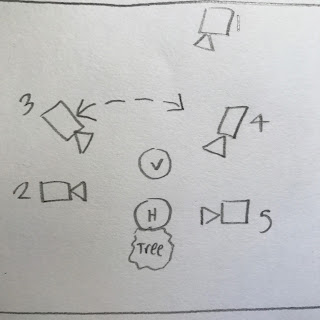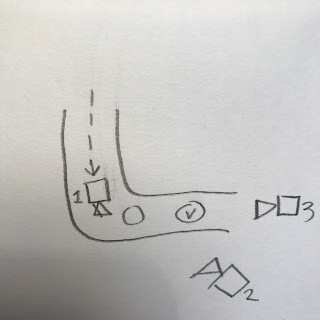ROLES OF THE GROUP:
When we are not in the scene as extras or main actors, me, Ruth and Anton will uptake different roles to ensure a smooth, productive shoot.
Ruth- Makeup, Costumes, Lighting
Ben- Composition of shots, Camerawork, Camera Angles, Positioning of Actors
Anton- Shot schedule (ensuring all shots are filmed and in correct, logical order)
Tom- Although in almost every shot, Tom will help with the composition of shots and camera work
For four of the main scenes which included multiple camera shots and camera movements we drew up rough shooting maps/floor plans to help us on the day of the shoot. These included numbered cameras telling us in what order to film specific shots, placement of actors and rough diagrams depicting the camera and actor movement. As well as helping us on the day, these diagrams helped us ensure that we didn't break the 180 degree rule as we could clearly see the position of each of our cameras.
When we are not in the scene as extras or main actors, me, Ruth and Anton will uptake different roles to ensure a smooth, productive shoot.
Ruth- Makeup, Costumes, Lighting
Ben- Composition of shots, Camerawork, Camera Angles, Positioning of Actors
Anton- Shot schedule (ensuring all shots are filmed and in correct, logical order)
Tom- Although in almost every shot, Tom will help with the composition of shots and camera work
For four of the main scenes which included multiple camera shots and camera movements we drew up rough shooting maps/floor plans to help us on the day of the shoot. These included numbered cameras telling us in what order to film specific shots, placement of actors and rough diagrams depicting the camera and actor movement. As well as helping us on the day, these diagrams helped us ensure that we didn't break the 180 degree rule as we could clearly see the position of each of our cameras.

This is the scene where the hero is tied to the tree being intimidated by the villain. As this scene effectively occurs twice (at the beginning and end) lots of shots are needed hence why there are 5 camera angles. Camera 3 will move back and forth capturing the action via a moving shot.
This is scene during the first verse. Because we are filming inside in a specific space, we knew the area we were working with well. We could therefore effectively plan where cameras should be placed to achieve the shots we wanted. Camera 3 breaks the 180 degree rule. However this is not an issue as camera 3 will be showing the audience the villains perspective.
This floor plan is a very rough guide to depict how we want the handheld, lip sync shots to happen. We'll film the scene once with Tom (playing the villain) walking and miming toward the camera and then once again where he is walking backwards away from the camera.

This is the floorplan for the scene where the villain fights with the anorak man. To help with seamless, continuous editing, this scene will have 3 camera shots which will be cut between. This helps the audience see al aspects of the fight and is far more effective than a single camera.







